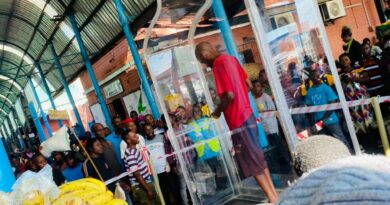Data Centres Face a Cooling Crisis as AI Demand Surges
Artificial intelligence is advancing not only industries but also the physical infrastructure that powers the digital economy. According to the International Energy Agency (IEA), inside a modern data centre, electricity is consumed across four main areas: storage systems (5%), networking equipment (5%), uninterruptible power supplies and backup generation (minimal, but critical for reliability), and cooling systems. It’s that last category that stands out. Depending on efficiency, cooling alone can consume anywhere from 7% in advanced hyperscale sites to over 30% in smaller or less-optimised enterprise facilities.
As AI workloads drive unprecedented power densities, with racks drawing 20–100kW or more, cooling shifts from a supporting role to a frontline constraint. For South Africa and much of Africa, this is magnified by high ambient temperatures, a historically unstable grid, and rapid growth in cloud and AI infrastructure. While the continent’s per-capita data centre electricity use remains below 1 kWh per person today, it is projected to double by the end of the decade, with South Africa leading the surge in demand as the hub for hyperscalers and sovereign AI projects.
This is the thermal tipping point: air cooling, once good enough, can no longer scale to handle the energy intensity of AI’s future, particularly in Africa’s climate and grid context.
Air Cooling Has Reached Its Limit
Air cooling has been the industry default for decades because it’s simple and cheap at low power densities. But when rack power draw jumps into the tens or hundreds of kilowatts, as AI-optimised racks do, air becomes inefficient: the temperature delta required gets larger, fans and CRAC units consume more power, and thermal throttling risks increase. Research and market analysis across 2023–2025 show an industry pivot toward liquid cooling, direct-to-chip or immersion, because liquid moves heat far more efficiently than air and reduces total facility PUE (power usage effectiveness).
Air-cooled systems can support up to approximately 70 kilowatts per rack in the data centre, but hit a physical limit when it comes to removing heat, known as ‘specific heat capacity’. Beyond this, operators need to look at alternative cooling methods. Adding to the complexity is the rise in demand for AI workloads across every industry, requiring five times the amount of power. The industry is now seeing a shift from chips operating at 120 watts to 600 watts or more.
Africa and South Africa: A Smaller footprint today, but fast growth ahead
Per-capita data centre electricity consumption in Africa remains low today, the IEA notes. Africa had less than 1 kWh per person of data centre electricity consumption in 2024, but is expected to roughly double toward the end of the decade as cloud adoption, hyperscaler investments, and sovereign AI projects scale up. Market research firms place Africa data centre power and cooling markets as high-growth segments in 2024–2025, signalling rapid investment but also rising on-site power demand.
South Africa is the regional leader in capacity and the obvious hub for hyperscaler and local large-scale deployments. Yet its grid has long operational constraints: coal still supplies the majority of electricity, and historically unstable supply (load-shedding) and rising peak demand have been persistent issues, though there were signals of improvement in 2024–2025; the structural challenges remain. This combination of rising local demand from data centres, heat-intensified cooling loads, and a constrained, carbon-intensive grid is why the cooling question is particularly acute in South Africa.
The climate: Hotter ambient temperatures reduce air cooling effectiveness
Higher ambient temperatures mean air cooling must work harder. In warm climates common across much of sub-Saharan Africa, the capacity margin available to dissipate high-density AI heat loads using air is much smaller than in temperate zones. That raises two problems. Higher operational costs, which means more fan and compressor energy, and a higher probability of hitting physical thermal limits that force performance throttling or prevent deployments altogether. Ember’s 2024–2025 electricity reviews show heatwaves already boosting residential A/C demand, meaning data centre cooling will compete more directly with other priority electricity uses.
What scalable alternatives and mitigations look like
To avoid hitting the thermal tipping point, Africa’s data centre industry will need a mix of innovations and policy support. The first is liquid cooling adoption, whether direct-to-chip or immersion, which has been proven to reduce cooling energy and enable far higher rack densities, essential for AI-heavy facilities. Second, operators must embrace on-site generation and co-located renewables, especially solar plus battery systems, which can ease peak grid loads and provide resilience against outages, a strategy that aligns with Africa’s accelerating solar boom.
A third opportunity is waste-heat reuse and district heating, which captures and exports server heat to improve overall efficiency, though practical deployment depends on local infrastructure. Fourth, governments should prioritise regulatory and power-market reforms: predictable tariffs, streamlined permits for on-site generation, and demand-response mechanisms can lower risk and unlock investment, as highlighted in OECD policy reviews.
Finally, Africa may need a hybrid edge vs. centralised model, distributing smaller edge sites for latency-sensitive services while building a few high-capacity, liquid-cooled hubs in locations with abundant low-carbon power, stronger grid capacity, or naturally cooler climates.
Risks if nothing changes
If the industry continues to rely on air cooling while AI workloads densify, three outcomes are likely to occur. Data centre PUEs will rise sharply in hot regions, making Africa a higher-cost location; projects may face repeated curtailments or throttling during heatwaves and peak grid stress; and lastly, the continent may miss economic opportunities tied to AI infrastructure. Think cloud revenue, developer ecosystems, and skills development. Research warns that while Africa’s absolute consumption is small today, its growth rate is what will stress local systems over the next 3–7 years.
Practical next steps for South Africa and African stakeholders
For South Africa and the wider continent, the practical next steps are clear. Policymakers and industry should incentivise pilot liquid-cooled AI hubs through grants or targeted tax measures to de-risk early adopters, while also accelerating approvals for hybrid power-plus-storage systems so data centres can integrate dedicated solar and battery solutions. Building partnerships between data centres and utilities will be key to securing firm capacity agreements and co-investing in grid reinforcement around strategic hubs. At the same time, regulators should publish transparent energy and water benchmarks for data centre projects, enabling evidence-based planning and accountability. Taken together, these actions will help ensure that the “thermal tipping point” does not become a ceiling on Africa’s digital ambitions.



